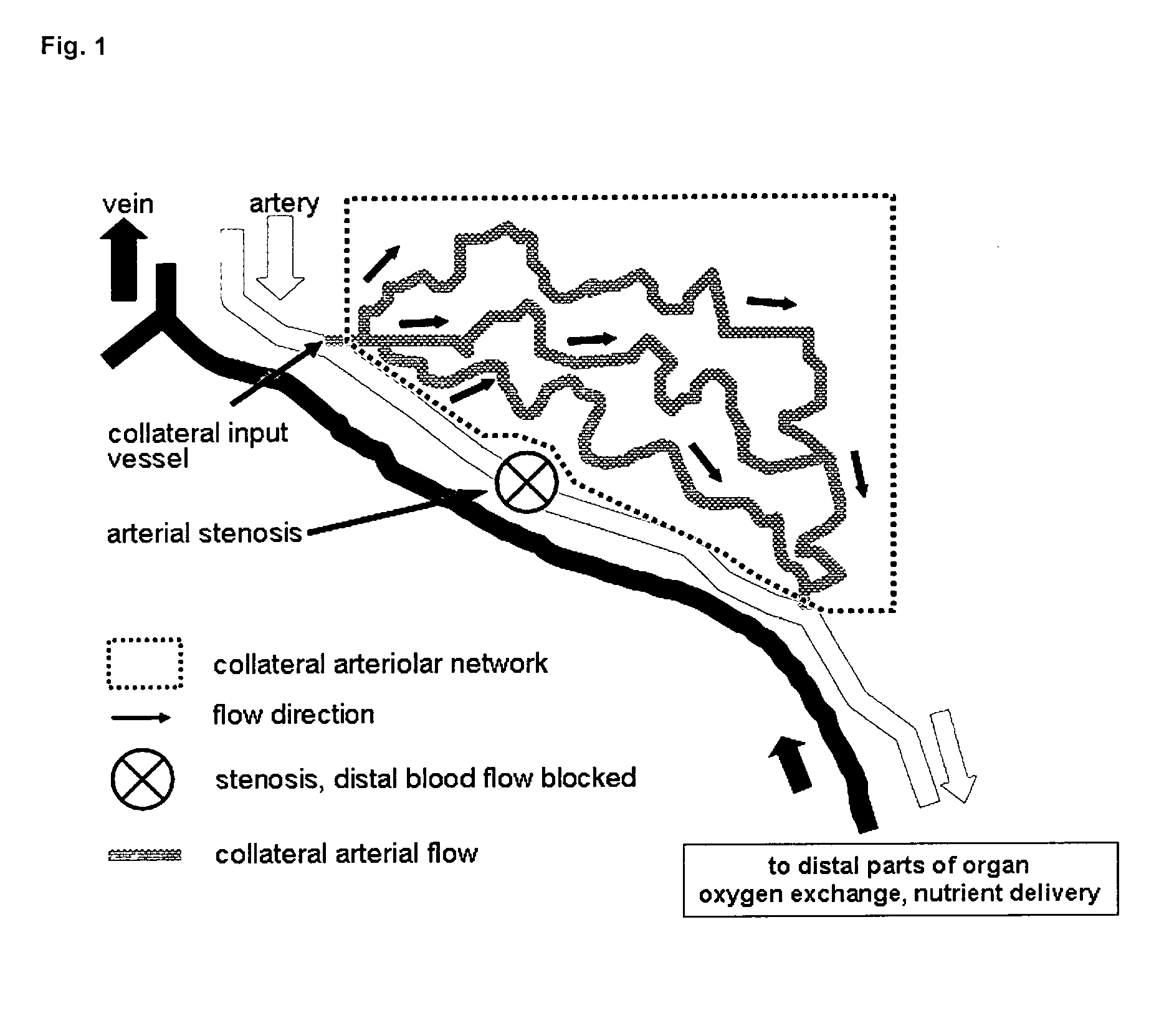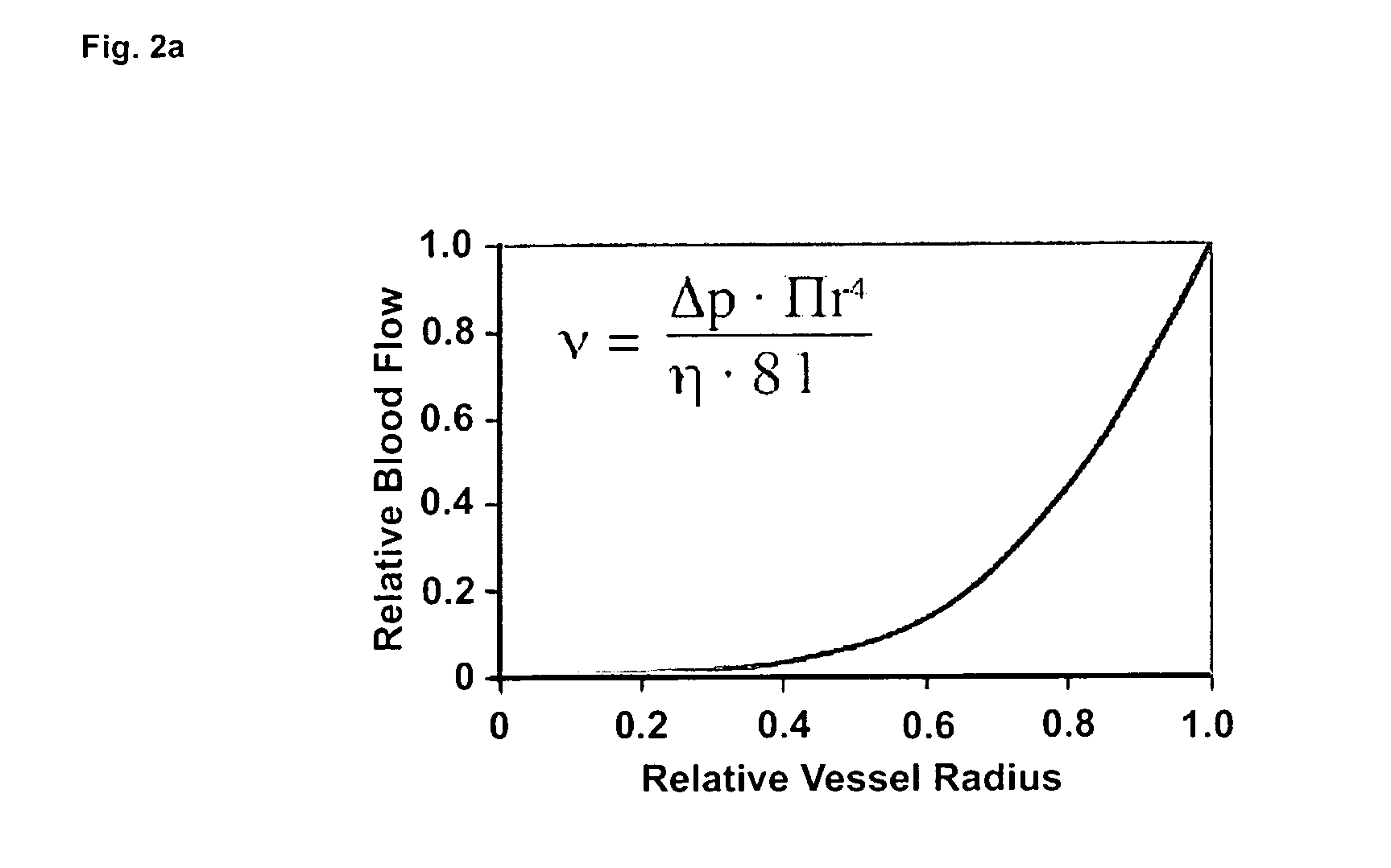Therapeutic use of agonists or antagonists of bradykinin receptor 1 or 2, for modulation collateral blood vessel growth
a technology of bradykinin receptor and agonist, which is applied in the direction of metabolism disorders, peptide/protein ingredients, peptide sources, etc., can solve the problems of unsatisfactory therapies, increased risk of restenosis, and difficult treatment of such diseases, and achieve the effect of inducing the migration of leukocyte cells and/or leucocyte precursor cells
- Summary
- Abstract
- Description
- Claims
- Application Information
AI Technical Summary
Benefits of technology
Problems solved by technology
Method used
Image
Examples
example 1
Measurement of Collateral Perfusion in the Femoral Ligature Model in the Mouse
[0281]Arteriogenesis was examined in an arteriogenesis model (ligation of the femoral artery) on the hind leg of C57 / Bl6 mice. The ligature of the femoral artery in hind leg of a mouse is an established model for examining arteriogenesis (Hoefer, van Royen et al. 2001). Here arteriogenesis is measured through the collateral perfusion rate of the hind leg arteries by pressure controlled perfusion with fluorescent microspheres (Molecular Probes) of various sizes (Bergmann, Hoefer et al. 2006). In brief, a number of fluorescent microspheres where normalized against a reference number of blue microspheres. Values are expressed as percent perfusion by comparing the ligated vs. the unligated leg. Calculating collateral perfusion rate is a functional measurement to evaluate collateral growth (arteriogenesis). Finally arteriogenesis can be estimated by a count of microspheres using flow cytometry (MACS Quant, Milt...
example 2
Pharmacological Inhibition of Bradykinin Receptor 1 and 2 Signaling in the 3-Vessel Occlusion (3-VO) Cerebral Arteriogenesis Model in Rat
[0283]Pharmacological modulation of arteriogenesis was analyzed using a 3 vessel occlusion (3-VO) model for cerebral arteriogenesis in the rat (Occlusion of both vertebral arteries and one carotid artery). Upon occlusion of three of four blood-supplying arteries to the brain, blood flow is redistributed by the recruitment of collateral pathways such as the posterior cerebral artery to supply the hypoperfusion area with blood. The 3-VO model in the rat has been established since 2003 and is acknowledged as a hypoperfusion model for testing cerebral arteriogenesis (Busch, Buschmann et al. 2003). By using the 3-VO model, relevant therapeutic stimulation of arteriogenesis was shown for instance by the application of GM-CSF (Buschmann, Circulation 2003).
[0284]Either by inhibition or stimulation of the bradykinin receptor signaling pathways, arteriogenes...
example 3
Therapeutic Stimulation of Arteriogenesis with a Selective BR1 Agonist in the 3-Vessel Occlusion (3-VO) Cerebral Arteriogenesis Model in Rat
[0288]FIG. 6 demonstrates therapeutic stimulation of arteriogenesis by using a selective bradykinin receptor 1 agonist Sar-[D-Phe]des-Arg9-bradykinin (R838). In the case of simultaneous application of the bradykinin receptor 1 agonist R838, it is demonstrated that seven days after 3-VO the diameter of the posterior cerebral artery (PCA) is significantly greater than the diameter in untreated rats after 3-VO (FIG. 6B,C). Furthermore FIG. 6D. shows that CVR is significantly increased through stimulation with a selective bradykinin receptor 1 agonist R838 (Sar-[D-Phe]des-Arg9-bradykinin). Arteriogenesis can by stimulated therapeutically by application of R838 for 1 week.
[0289]In summary the examples demonstrate that cerebral arteriogenesis is significantly inhibited by antagonists via blocking the bradykinin receptors (FIG. 5). Stimulation with a s...
PUM
| Property | Measurement | Unit |
|---|---|---|
| molecular mass | aaaaa | aaaaa |
| diameter | aaaaa | aaaaa |
| diameter | aaaaa | aaaaa |
Abstract
Description
Claims
Application Information
 Login to View More
Login to View More - R&D
- Intellectual Property
- Life Sciences
- Materials
- Tech Scout
- Unparalleled Data Quality
- Higher Quality Content
- 60% Fewer Hallucinations
Browse by: Latest US Patents, China's latest patents, Technical Efficacy Thesaurus, Application Domain, Technology Topic, Popular Technical Reports.
© 2025 PatSnap. All rights reserved.Legal|Privacy policy|Modern Slavery Act Transparency Statement|Sitemap|About US| Contact US: help@patsnap.com



